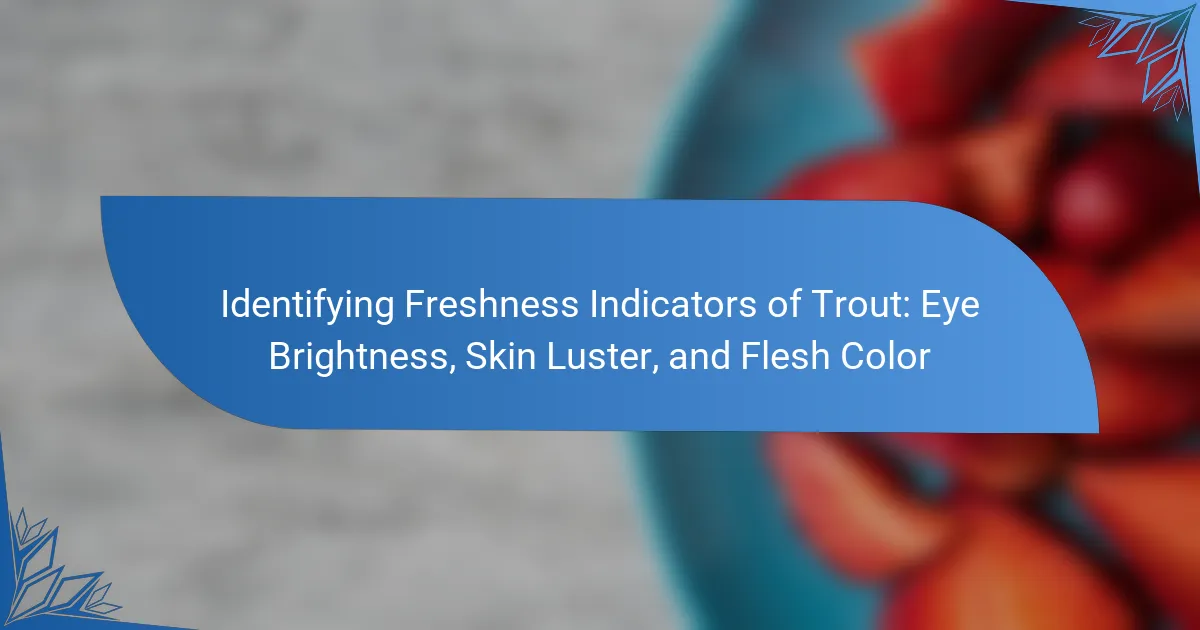
What are the Freshness Indicators of Sardines?
Freshness indicators of sardines include skin shine, gill color, and texture. Fresh sardines exhibit a bright, shiny skin that reflects light. Dull or discolored skin suggests age or spoilage. The gills of fresh sardines should be bright red or pink. Dark or brown gills indicate that the fish is not fresh. Texture is also crucial; fresh sardines feel firm to the touch. A mushy or soft texture is a sign of deterioration. These indicators help consumers assess the quality of sardines before purchase.
How do Skin Shine, Gills Color, and Texture indicate freshness?
Skin shine, gills color, and texture are critical indicators of sardine freshness. Fresh sardines exhibit a bright, reflective skin, indicating moisture and vitality. Dull or matte skin suggests age or spoilage. The gills of fresh sardines are typically a vibrant red or pink. This coloration results from healthy blood flow and oxygenation. Gills that appear brown or gray indicate deterioration. Texture is also vital; fresh sardines feel firm to the touch. A soft or mushy texture suggests that the fish is no longer fresh. These characteristics collectively help consumers assess the quality and freshness of sardines before purchase.
What does a shiny skin signify about the freshness of sardines?
A shiny skin signifies that sardines are fresh. Fresh sardines have a moist and reflective surface. This shine indicates that the fish has not been exposed to prolonged air or drying. A dull or faded skin suggests deterioration or age. Freshness is crucial for quality and flavor in sardines. The appearance of the skin can be a reliable indicator. Consumers often look for this shine when selecting sardines. It is a visual cue of optimal freshness.
How can the color of gills reveal the quality of sardines?
The color of gills can indicate the quality of sardines. Fresh sardines typically have bright red or pink gills. This vibrant color suggests that the fish is still alive or was just recently caught. Dull or brown gills indicate that the sardines are older and may not be as fresh. The gill color changes due to the breakdown of blood and tissue as the fish ages. A fresh sardine will retain its gill color longer than one that has begun to spoil. Therefore, examining gill color is a practical method to assess sardine freshness.
What role does texture play in assessing sardine freshness?
Texture is a critical indicator of sardine freshness. Fresh sardines exhibit firm, resilient flesh. This firmness indicates that the fish has not begun to decompose. A mushy or soft texture suggests spoilage and loss of quality. The skin should also feel smooth and taut. Any stickiness or excessive softness can indicate bacterial growth. Evaluating texture is essential for consumers and sellers to ensure quality. Studies have shown that texture assessment correlates with overall freshness ratings in seafood.
Why are these indicators important for consumers?
Freshness indicators of sardines are important for consumers because they directly affect the quality and safety of the fish. Skin shine indicates freshness; a shiny appearance suggests the fish is recently caught. Gills color also matters; bright red gills indicate a fresh fish, while dull or brown gills suggest spoilage. Texture is crucial as well; firm flesh signifies freshness, while mushy texture indicates deterioration. These indicators help consumers make informed choices, ensuring they purchase safe and high-quality seafood. Research shows that consumers often rely on visual cues to assess freshness, highlighting the significance of these indicators in the purchasing process.
How do freshness indicators affect the taste and safety of sardines?
Freshness indicators significantly impact the taste and safety of sardines. Key indicators include skin shine, gill color, and texture. A shiny skin suggests the fish is fresh, enhancing its flavor profile. Dull skin often indicates spoilage, leading to off-flavors. Bright red gills signify freshness and optimal safety. If gills appear brown or faded, the fish may be unsafe to consume. Firm texture indicates freshness, while a mushy feel suggests deterioration. Research shows that fresh sardines retain better taste and nutritional value. Consuming fresh sardines minimizes health risks associated with spoiled fish.
What should consumers look for when purchasing sardines?
Consumers should look for specific freshness indicators when purchasing sardines. Fresh sardines typically have shiny, reflective skin. The gills should be bright red or pink, indicating freshness. Additionally, the flesh should feel firm to the touch. A fish that is soft may not be fresh. The eyes of the sardines should be clear and bulging, not sunken. Smell is also important; fresh sardines should have a mild ocean scent, not a strong fishy odor. These indicators help ensure the quality and safety of the sardines.

What specific characteristics define Skin Shine in Sardines?
Skin shine in sardines is characterized by a bright, reflective surface that indicates freshness. This shine results from a healthy layer of mucus, which protects the fish and enhances its appearance. Fresh sardines exhibit a smooth texture without any dullness or dryness. The skin should also maintain a vibrant coloration, typically silver or iridescent, which signifies quality. Additionally, the presence of skin shine suggests that the sardines have been properly handled and stored. Research shows that fish with high skin shine scores are often linked to better overall quality and taste. Thus, skin shine serves as a reliable indicator of sardine freshness and quality.
How can one identify the optimal shine on sardine skin?
The optimal shine on sardine skin can be identified by its reflective quality and vibrant appearance. Fresh sardines exhibit a bright, metallic sheen that indicates quality. The skin should appear smooth and moist, without any dullness or dryness. When examining the sardine, look for a uniform shine across the body. This shine is a sign of freshness and proper handling. Additionally, a healthy sardine’s skin will have an iridescent quality, which enhances its visual appeal. In contrast, a lack of shine may indicate aging or spoilage.
What factors contribute to the shine of sardine skin?
The shine of sardine skin is primarily influenced by the presence of natural oils and the fish’s hydration level. Natural oils create a reflective surface that enhances shine. Additionally, a well-hydrated sardine maintains a smooth texture, contributing to its luster. The skin’s coloration also plays a role; vibrant, healthy skin tends to reflect light better. Fresh sardines exhibit a glossy appearance, indicating their quality and freshness. These factors combined create the desirable shine associated with high-quality sardine skin.
How does the shine relate to the overall quality of sardines?
The shine of sardines is a key indicator of their overall quality. A bright, reflective surface suggests freshness and proper handling. Dull or faded skin often indicates age or spoilage. Fresh sardines retain moisture, contributing to their shine. This shine can also be linked to the fish’s fat content, which is desirable in sardines. Research shows that high-quality sardines exhibit a vibrant sheen, reflecting their optimal freshness. Therefore, shine serves as a reliable visual cue for consumers assessing sardine quality.

What does Gills Color reveal about the freshness of Sardines?
The gill color of sardines indicates their freshness. Fresh sardines have bright red or pink gills. Dull or brown gills suggest that the fish is not fresh. The color change occurs due to the breakdown of blood and tissues. This deterioration happens as the fish ages. Bright gills indicate that the fish has been recently caught. Conversely, dark gills may signify spoilage or extended storage. Therefore, examining gill color is a reliable method for assessing sardine freshness.
What colors should consumers look for in sardine gills?
Consumers should look for bright red or pink colors in sardine gills. These colors indicate freshness and good quality. Dull or brownish gills suggest that the sardines are older or less fresh. Fresh sardines typically have gills that are vibrant, which is a sign of healthy blood circulation. The intensity of the color can vary based on the species, but bright hues are universally preferred. This visual cue is essential for ensuring the quality of the fish before purchase.
How does the gill color change as sardines age?
As sardines age, their gill color transitions from bright red to a duller hue. Young sardines exhibit vibrant red gills, indicating freshness and health. As they mature, the gills become less vibrant and may turn brownish or gray. This change in color is due to the breakdown of hemoglobin and the accumulation of metabolic waste. Older sardines often show signs of deterioration, which is reflected in their gill color. Research indicates that gill color serves as a reliable indicator of fish freshness. Therefore, assessing gill color can help determine the age and quality of sardines.
What are the implications of abnormal gill colors?
Abnormal gill colors in sardines indicate potential spoilage or disease. Healthy gills are typically bright red or pink, signaling freshness. Dull, brown, or gray gills suggest deterioration. This change may result from bacterial growth or poor handling practices. Research shows that gill color is a reliable freshness indicator. Studies indicate that consumers often associate vibrant gills with quality. Therefore, abnormal gill colors can deter buyers and impact market value.

How does Texture influence the perception of Sardine Freshness?
Texture significantly influences the perception of sardine freshness. A firm texture is often associated with high freshness levels in fish. Conversely, a mushy or soft texture can indicate spoilage. Fresh sardines typically exhibit a resilient flesh that springs back when pressed. This tactile response is a key indicator of quality. Studies show that consumers often rely on texture to evaluate fish freshness. For instance, a study published in the Journal of Food Science found that texture was one of the most critical factors in determining freshness perception among consumers. Thus, texture serves as a vital component in assessing the overall quality of sardines.
What are the signs of a fresh texture in sardines?
Fresh sardines exhibit a firm texture. The flesh should feel resilient and spring back when pressed. A fresh sardine will not have a mushy or soft texture. The skin appears shiny and moist, indicating freshness. Additionally, the scales should be intact and not easily fall off. Fresh sardines will also have a clean smell, devoid of any sour or fishy odor. These characteristics collectively signify that the sardines are fresh and of good quality.
How does the texture of sardines vary with different preservation methods?
The texture of sardines varies significantly with different preservation methods. Fresh sardines have a firm and flaky texture. Canning typically results in a softer, more tender texture due to the cooking process involved. Smoked sardines tend to have a firmer texture with a distinct smokiness that alters the mouthfeel. Freezing can cause some texture degradation, leading to a slightly mushy consistency upon thawing. Each preservation method impacts the moisture content and structural integrity of the fish. For instance, canned sardines retain moisture, while dried sardines lose moisture and become chewier. These variations are essential indicators of freshness and quality in sardines.
What texture changes indicate spoilage in sardines?
Texture changes indicating spoilage in sardines include a slimy or sticky surface. Fresh sardines should have a firm texture. When the flesh becomes mushy, it signals deterioration. Additionally, the presence of excessive moisture can indicate spoilage. Discoloration of the flesh may also accompany these texture changes. Spoiled sardines may lose their original firmness and bounce. These texture alterations are often accompanied by an off-putting odor. Such signs are critical for assessing the freshness of sardines.
What practical tips can help consumers assess the freshness of sardines?
To assess the freshness of sardines, consumers should examine several key indicators. First, check the skin shine; fresh sardines have a bright, metallic sheen. Dull or dry skin indicates age or spoilage. Next, observe the gills; they should be bright red or pink. Dark or brown gills suggest that the fish is no longer fresh. Additionally, feel the texture; fresh sardines should feel firm to the touch. If the flesh is mushy, it is likely past its prime. Lastly, pay attention to the smell; fresh sardines should have a mild, ocean-like scent. A strong, fishy odor indicates spoilage.
How can consumers effectively evaluate skin shine, gills color, and texture when buying sardines?
Consumers can evaluate skin shine, gills color, and texture when buying sardines by following specific indicators. Skin shine should appear bright and reflective, indicating freshness. Dull or dry skin suggests the fish is not fresh. Gills color should be vibrant red or pink, signaling healthy and fresh sardines. Gills that are brown or gray indicate spoilage. Texture is crucial; fresh sardines should feel firm to the touch. If the flesh is mushy or breaks apart easily, it is likely past its prime. These evaluations are based on the sensory characteristics of fresh fish, which indicate quality and safety for consumption.
What are common mistakes to avoid when checking sardine freshness?
Common mistakes to avoid when checking sardine freshness include ignoring the skin’s shine. Fresh sardines should have a bright, reflective skin. Dull or dry skin indicates age or spoilage. Another mistake is not examining the gills’ color. Fresh gills should be bright red or pink. Brown or gray gills suggest that the fish is no longer fresh. Additionally, overlooking the texture is a mistake. Fresh sardines should feel firm and resilient. Soft or mushy flesh indicates deterioration. Finally, failing to smell the sardines can lead to errors. A strong, unpleasant odor is a sign of spoilage.
The main entity of the article is sardines, specifically focusing on their freshness indicators, which include skin shine, gill color, and texture. The article outlines how these indicators help consumers assess the quality and safety of sardines before purchase, emphasizing that fresh sardines exhibit bright, shiny skin, vibrant red or pink gills, and a firm texture. It details the implications of these characteristics on flavor and health, offers practical tips for consumers to evaluate freshness, and discusses common mistakes to avoid during the assessment process. Overall, the article serves as a guide for identifying high-quality sardines based on visual and tactile cues.



